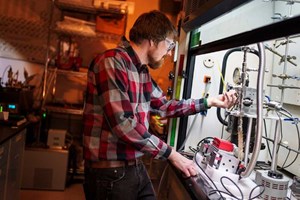News
Sandia National Laboratories studies subterranean storage of H2
Imagine a vast volume of porous sandstone reservoir, once full of oil and natural gas, now full of a different, carbon-free fuel: H2. Sandia scientists are using computer simulations and laboratory experiments to see if depleted oil and natural gas reservoirs can be used for storing this carbon-free fuel. H2 is an important clean fuel: It can be made by splitting water using solar or wind power, it can be used to generate electricity and to power heavy industry, and it could be used to energize fuel-cell-based vehicles. Additionally, H2 could be stored for months and used when energy needs outpace the supply delivered by renewable energy sources.

“H2 would be good for seasonal and long-term storage,” said Sandia chemical engineer Tuan Ho, who is leading the research. “If you think of solar energy, in the summer you can produce a lot of electricity, but you don’t need a lot for heating. The excess can be turned into H2 and stored until winter.”
“However, H2 contains much less bang in a set volume than carbon-based fuels such as natural gas or propane and is much more difficult to compress, Tuan said. This means storing huge amounts of H2 in metal tanks on the surface is just not feasible.”
“H2 can be stored underground in salt caverns, but salt deposits are not widespread across the U.S.,” said Don Conley, the manager for Sandia’s underground H2 storage work. “Therefore, Tuan’s team is studying if H2 stored in depleted oil and gas reservoirs will get stuck in the rock, leak out or get contaminated.”
Tuan’s team recently shared their findings in a paper published in the International Journal of Hydrogen Energy.
Leaky rocks or secure storage? First, Tuan’s team studied if H2 would get stuck in the sandstone or shale that forms the body and seals around many oil and gas reservoirs, or if the gas would leak out. Sandstone is composed of sand-sized grains of minerals and rocks that have been compressed over eons; sandstone has a lot of gaps between particles and thus can store water in aquifers or form oil and gas reservoirs. Shale is mud compressed into rock and is made up of much smaller particles of clay-rich minerals. Thus, shale can form a seal around sandstone, trapping oil and natural gas.
“You want the H2 to stay where you inject it,” Tuan said. “You don’t want it to migrate away from the storage zone and get lost. That’s just a waste of money, which is a big concern for any storage facility.”
“Tuan’s collaborators at the University of Oklahoma used experiments to study how H2 interacts with samples of sandstone and shale. They found that H2 does not stay inside sandstone after it is pumped out, but up to 10% of the adsorbed gas got stuck inside the shale sample,” Tuan said. These results were confirmed by Tuan’s computer simulations.
Taking a closer look at a specific type of clay that is common in the shale around oil and gas reservoirs, Tuan conducted computer simulations of the molecular interactions between layers of montmorillonite clay, water and H2. He found that H2 does not prefer to go into the watery gaps between mineral layers of that kind of clay.
“This means that the loss of H2 in clay due to getting stuck or moving through it would be tiny,” Tuan said. This is quite positive for underground storage of H2. These findings on clay were published last year in the journal Sustainable Energy and Fuels.
Additional absorption experiments are being conducted at Stevens Institute of Technology and the University of Oklahoma to confirm the molecular simulation results, according to Tuan.
Risks of contamination? Using both experiments and simulation, Tuan’s team found that residual natural gas can be released from the rock into the H2 when H2 is injected into a depleted natural gas reservoir. “This means that when the H2 is removed for use, it will contain a small amount of natural gas,” Tuan said.
“That’s not terrible because natural gas still has energy, but it contains carbon, so when this H2 is burned, it will produce a small amount of carbon dioxide,” Tuan said. “It’s something we need to be aware of.”
Tuan’s team, principally Sandia postdoctoral researcher Aditya Choudhary, is currently studying the effects of H2 on a depleted oil reservoir and how leftover oil might contaminate or interact with H2 gas using both molecular simulations and experiments.
“The findings from Tuan’s research can be used to inform and guide large field-scale tests of underground H2 storage,” said Don, who also manages Sandia’s portion of DOE Office of Fossil Energy and Carbon Management’s Subsurface H2 Assessment, Storage and Technology Acceleration project. “The project plans to conduct such a field-scale test in the future to demonstrate the feasibility of depleted oil and natural gas reservoirs for H2 storage.”
Additional research is needed to understand how microorganisms and other chemicals in depleted petroleum reservoirs might interact with stored H2, Tuan said.
“If we want to create a H2 economy, we really need widely distributed means of storing large quantities of H2,” Don said. “Storage in salt is excellent where it exists, but it can’t be the sole option. So, we’re turning to depleted oil and gas reservoirs and aquifers as more geologically distributed means of storing large quantities of H2. It’s all in the name of decarbonizing the energy sector.”
The project is funded by Sandia’s Laboratory Directed Research and Development program.

